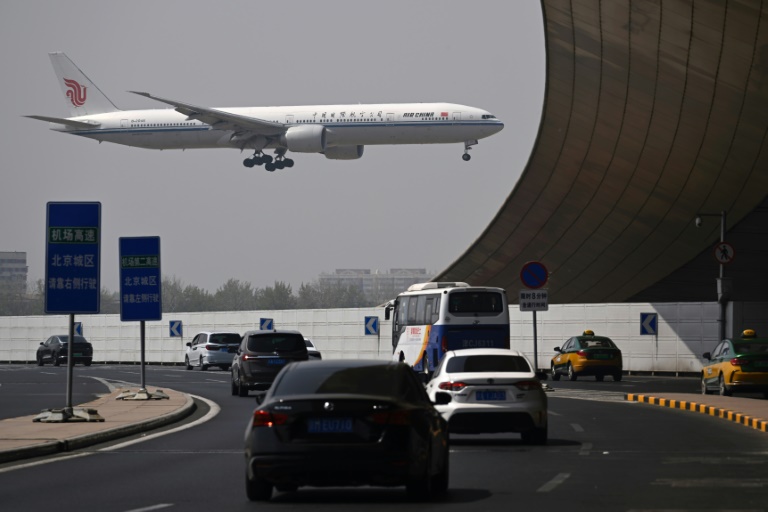Growing public concern over underground safety amid series of sinkholes and collapses (KOR) Published: 14 Apr. 2025, 09:08 A sinkhole near Aeogae Station on Line No. 5, on April 13 [JOONGANG ILBO] A recent string of underground accidents has exposed serious flaws in Korea’s management of subsurface infrastructure.
From tunnel collapses to sinkholes, the incidents are prompting renewed concern over safety in a part of the city most people rarely see, but increasingly rely on. On April 11, a tunnel under construction for the Shinansan Line in Gwangmyeong, Gyeonggi, collapsed. Two workers were trapped; one was rescued after 13 hours, the other remains missing.

More than 2,000 residents were evacuated in fear of further collapse. Just days later, a sinkhole opened near Aeogae Station on Seoul's Line No. 5, disrupting traffic.
Another appeared near the Sasang-Hadan subway construction site in Busan. Last month, a 20-meter-wide (66-foot-wide) sinkhole in Gangdong District swallowed a motorcyclist, who died. Related Article Sinkhole appears near rail construction site in Busan, no injuries reported Sinkhole in Seoul's Gangdong District traps SUV and motorcycle, injures one Sinkhole opens up in Incheon partially swallowing cargo truck Construction? Climate change? As sinkholes open in Seoul, causes remain a mystery.
While each case had its own immediate cause — whether structural failure, flawed construction methods or external environmental stress — they all occurred underground. That shared context points to a broader issue: Korea’s underground space is rapidly expanding, but oversight has not kept pace. In Gwangmyeong, reports of cracks in a tunnel pillar were filed 15 hours before the collapse.
The Gangdong sinkhole is suspected to be linked to an ongoing extension on Seoul's Subway Line No. 9. In Busan, a similar sinkhole occurred at the same site last September.
At Aeogae, investigations are still underway. More troubling is that the city’s own data may be insufficient. Seoul maintains maps identifying high-priority maintenance zones, based on utility networks and infrastructure.
But the data lacks accuracy, a flaw city officials admit. While some have speculated that information is withheld to avoid disrupting property markets, the city denies this. Access to an intersection in Gangdong District, eastern Seoul, remains restricted on March 25 after a sinkhole swallowed a motorcyclist the previous day.
The 34-year-old rider was found dead after a 17-hour search. [NEWS1] What is clear is that Korea’s underground requires more than just patchwork fixes. Detailed geotechnical surveys, safety audits of aging infrastructure and the creation of reliable “risk maps” should be top priorities.
Seoul has pledged to deliver these, but action must follow swiftly. Underground systems are easy to ignore — until they fail. Much of Seoul’s subsurface infrastructure dates back to the 1960s and 1980s, when the city was growing fast.
These aging pipes and tunnels are now liabilities. Local governments must recognize that underground safety is not a peripheral issue. It is central to urban life, and when neglected, the consequences surface fast.
Translated from the JoongAng Ilbo using generative AI and edited by Korea JoongAng Daily staff. 공사장 붕괴와 싱크홀 발생..
.지하 공간이 불안하다 광명시 지하 공사 현장 무너져 주민 긴급 대피 서울·부산 또 싱크홀, 지하 공간 안전관리 시급 최근 한 달간 지하 공간에서 잇따라 발생한 사고로 지하 공간 안전관리에 대한 시민들의 불안감이 커지고 있다. 지난 11일 경기도 광명시 신안산선 지하터널 공사 현장에선 대형 붕괴사고가 발생했다.
이날 사고 현장에서 빠져나오지 못한 작업자 두 명 중 한 명은 13시간 만에 구조됐고, 다른 한 명은 여전히 실종 상태다. 현장 주변에 사는 주민 2000여 명은 추가 붕괴 우려로 긴급 대피하는 등 놀란 가슴을 쓸어내려야 했다. 어제 오전에는 서울 마포구 지하철 5호선 애오개역 인근 도로에서 싱크홀(땅 꺼짐)이 발생해 한때 주변 교통이 통제됐고, 부산시 사상구의 사상~하단선 도시철도 공사 현장 인근에서도 대형 싱크홀이 발생했다.
지난달 24일에는 서울 강동구 명일동에서 지름 20m의 대형 싱크홀이 발생해 오토바이 운전자 한 명이 사망하는 사고도 있었다. 사고 원인은 제각각이지만 공통점은 발생 장소가 지하 공간이란 점이다. 인구가 밀집한 도시의 지하 공간에서 도대체 무슨 일이 벌어지고 있는지 불안감이 커지고 있다.
광명의 신안산선 공사장에선 이미 사고 발생 15시간 전부터 공사 중인 지하터널 가운데 기둥에서 균열이 발생했다는 신고가 관계당국에 접수되기도 했다. 명일동 싱크홀은 주변에서 진행 중이던 지하철 9호선 연장 공사가 원인일 수 있다는 전문가 의견이 제시된 상태다. 부산시 사상~하단선 공사 현장에선 지난해 9월에도 대형 싱크홀이 생겼는데 당시에는 폭우와 부실한 공법 등이 사고 원인으로 지목됐다.
애오개역 앞 싱크홀은 서울시 서부도로사업소 등이 사고 원인을 조사 중이다. 지반 침하 위험도를 고려한 지하 공간의 상세 지도를 만드는 작업도 속도를 낼 필요가 있다. 서울시가 상·하수도관과 가스·통신관 등의 정보를 종합한 ‘우선정비구역도’란 자료가 있지만 정확성이 떨어져 보완이 시급한 것으로 드러났다.
서울시도 솔직히 인정하는 부분이다. 일부에선 ‘집값 민원’ 때문에 지하 정보를 비공개한 게 아니냐는 주장도 나왔지만, 서울시는 인정하지 않았다. 이런 부정확한 정보로 혼란을 주지 않기 위해서라도 상세한 지질 정보와 지반 침하 위험도를 분석한 ‘안전지도’를 만들겠다는 게 서울시의 설명이다.
도시 관리에서 지하 공간은 그 중요성에 비해 자칫 소홀히 다루기 쉬운 영역이다. 평상시 눈으로 보이지 않고 지방자치단체장이 치적으로 내세우기 어려운 게 현실이기 때문이다. 그렇다고 경계를 늦춰선 안 된다.
특히 서울시는 인구 팽창기인 1960~80년대에 매설한 상·하수도관 등 노후 지하 시설물이 적지 않은 형편이다. 지하 공간의 안전하고 체계적인 관리는 시민의 생명과 직결되는 문제라는 사실을 명심해야 한다..
Growing public concern over underground safety amid series of sinkholes and collapses (KOR)

A sinkhole near Aeogae Station on Line No. 5, on April 13 [JOONGANG ILBO] A recent string of underground accidents has exposed serious flaws in Korea’s management of subsurface infrastructure. From tunnel collapses to sinkholes, the incidents are prompting renewed concern over safety in a part of the city most people rarely see, but increasingly rely on. On April 11, a tunnel under construction for the Shinansan Line in Gwangmyeong, Gyeonggi, collapsed. Two workers were trapped; one was rescued after 13 hours, the other remains missing. More than 2,000 residents were evacuated in fear of further collapse. Just days later, a sinkhole opened near Aeogae Station on Seoul's Line No. 5, disrupting traffic. Another appeared near the Sasang-Hadan subway construction site in Busan. Last month, a 20-meter-wide (66-foot-wide) sinkhole in Gangdong District swallowed a motorcyclist, who died. Related ArticleSinkhole appears near rail construction site in Busan, no injuries reportedSinkhole in Seoul's Gangdong District traps SUV and motorcycle, injures oneSinkhole opens up in Incheon partially swallowing cargo truckConstruction? Climate change? As sinkholes open in Seoul, causes remain a mystery. While each case had its own immediate cause — whether structural failure, flawed construction methods or external environmental stress — they all occurred underground. That shared context points to a broader issue: Korea’s underground space is rapidly expanding, but oversight has not kept pace. In Gwangmyeong, reports of cracks in a tunnel pillar were filed 15 hours before the collapse. The Gangdong sinkhole is suspected to be linked to an ongoing extension on Seoul's Subway Line No. 9. In Busan, a similar sinkhole occurred at the same site last September. At Aeogae, investigations are still underway. More troubling is that the city’s own data may be insufficient. Seoul maintains maps identifying high-priority maintenance zones, based on utility networks and infrastructure. But the data lacks accuracy, a flaw city officials admit. While some have speculated that information is withheld to avoid disrupting property markets, the city denies this. Access to an intersection in Gangdong District, eastern Seoul, remains restricted on March 25 after a sinkhole swallowed a motorcyclist the previous day. The 34-year-old rider was found dead after a 17-hour search. [NEWS1] What is clear is that Korea’s underground requires more than just patchwork fixes. Detailed geotechnical surveys, safety audits of aging infrastructure and the creation of reliable “risk maps” should be top priorities. Seoul has pledged to deliver these, but action must follow swiftly. Underground systems are easy to ignore — until they fail. Much of Seoul’s subsurface infrastructure dates back to the 1960s and 1980s, when the city was growing fast. These aging pipes and tunnels are now liabilities. Local governments must recognize that underground safety is not a peripheral issue. It is central to urban life, and when neglected, the consequences surface fast. Translated from the JoongAng Ilbo using generative AI and edited by Korea JoongAng Daily staff. 공사장 붕괴와 싱크홀 발생...지하 공간이 불안하다 광명시 지하 공사 현장 무너져 주민 긴급 대피 서울·부산 또 싱크홀, 지하 공간 안전관리 시급 최근 한 달간 지하 공간에서 잇따라 발생한 사고로 지하 공간 안전관리에 대한 시민들의 불안감이 커지고 있다. 지난 11일 경기도 광명시 신안산선 지하터널 공사 현장에선 대형 붕괴사고가 발생했다. 이날 사고 현장에서 빠져나오지 못한 작업자 두 명 중 한 명은 13시간 만에 구조됐고, 다른 한 명은 여전히 실종 상태다. 현장 주변에 사는 주민 2000여 명은 추가 붕괴 우려로 긴급 대피하는 등 놀란 가슴을 쓸어내려야 했다. 어제 오전에는 서울 마포구 지하철 5호선 애오개역 인근 도로에서 싱크홀(땅 꺼짐)이 발생해 한때 주변 교통이 통제됐고, 부산시 사상구의 사상~하단선 도시철도 공사 현장 인근에서도 대형 싱크홀이 발생했다. 지난달 24일에는 서울 강동구 명일동에서 지름 20m의 대형 싱크홀이 발생해 오토바이 운전자 한 명이 사망하는 사고도 있었다. 사고 원인은 제각각이지만 공통점은 발생 장소가 지하 공간이란 점이다. 인구가 밀집한 도시의 지하 공간에서 도대체 무슨 일이 벌어지고 있는지 불안감이 커지고 있다. 광명의 신안산선 공사장에선 이미 사고 발생 15시간 전부터 공사 중인 지하터널 가운데 기둥에서 균열이 발생했다는 신고가 관계당국에 접수되기도 했다. 명일동 싱크홀은 주변에서 진행 중이던 지하철 9호선 연장 공사가 원인일 수 있다는 전문가 의견이 제시된 상태다. 부산시 사상~하단선 공사 현장에선 지난해 9월에도 대형 싱크홀이 생겼는데 당시에는 폭우와 부실한 공법 등이 사고 원인으로 지목됐다. 애오개역 앞 싱크홀은 서울시 서부도로사업소 등이 사고 원인을 조사 중이다. 지반 침하 위험도를 고려한 지하 공간의 상세 지도를 만드는 작업도 속도를 낼 필요가 있다. 서울시가 상·하수도관과 가스·통신관 등의 정보를 종합한 ‘우선정비구역도’란 자료가 있지만 정확성이 떨어져 보완이 시급한 것으로 드러났다. 서울시도 솔직히 인정하는 부분이다. 일부에선 ‘집값 민원’ 때문에 지하 정보를 비공개한 게 아니냐는 주장도 나왔지만, 서울시는 인정하지 않았다. 이런 부정확한 정보로 혼란을 주지 않기 위해서라도 상세한 지질 정보와 지반 침하 위험도를 분석한 ‘안전지도’를 만들겠다는 게 서울시의 설명이다. 도시 관리에서 지하 공간은 그 중요성에 비해 자칫 소홀히 다루기 쉬운 영역이다. 평상시 눈으로 보이지 않고 지방자치단체장이 치적으로 내세우기 어려운 게 현실이기 때문이다. 그렇다고 경계를 늦춰선 안 된다. 특히 서울시는 인구 팽창기인 1960~80년대에 매설한 상·하수도관 등 노후 지하 시설물이 적지 않은 형편이다. 지하 공간의 안전하고 체계적인 관리는 시민의 생명과 직결되는 문제라는 사실을 명심해야 한다.











